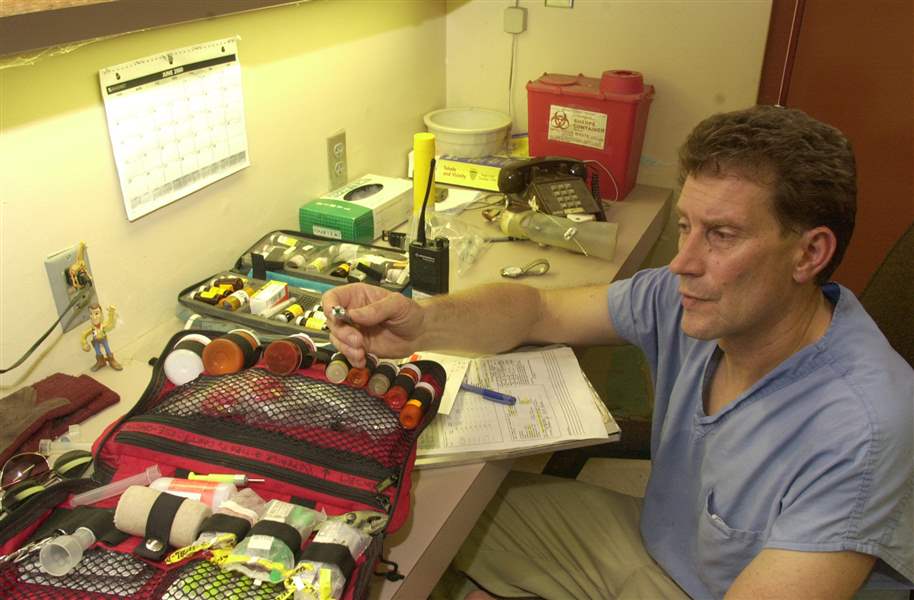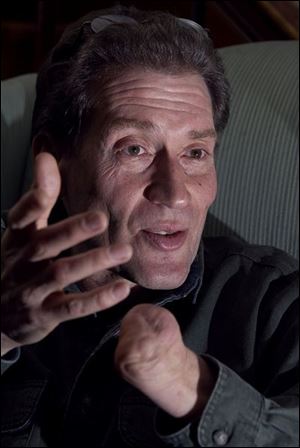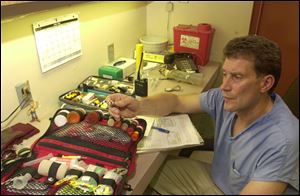
Fired zoo veterinarian's file mostly positive, with a few concerns
3/9/2005
Dr. Tim Reichard, shown at the Toledo Zoo in this 2000 photo, says he always felt that everyone responsible for animal care at the zoo had to work together as a team.
THE BLADE
Buy This Image

Dr. Tim Reichard
Until April, 2004, Dr. Tim Reichard had an employee record that most people would envy, a review yesterday of the former Toledo Zoo veterinarian's personnel file revealed.
It was filled with positive job evaluations and annual merit raises. Yet zoo officials say they fired the veterinarian after 22 years of service due to "several years" of unresolved problems.
Robert Harden, the zoo's chief operating officer, said while Dr. Reichard's problems may not have been obvious in the personnel file, "They may have been more or less alluded to. We saw problems. We tried to solve those problems."
Amid the glowing commendations in the file, there were occasional negative comments, a hint of an employee who was good at his job, but not as good at making people like him.
"Tim can be intense and inflexible, causing strained relations with fellow employees,'' one former supervisor wrote in a 2000 evaluation. Still, the supervisor said Dr. Reichard "gets along reasonably well.''
There was no disciplinary action in his file, or even the hint of deep concern, until two months after Dr. Reichard spoke frankly to an inspector from the U.S. Department of Agriculture in February of 2004 about his concerns about animal care at the zoo. His comments led to unfavorable citations for the Toledo Zoo regarding animal care issues in a federal inspection report issued that month.
Two months later, in April, Dr. Reichard received his first warning from zoo administrators.
"We need to have team players, and you need to work through these issues in a more professional, less 'attacking' manner," the warning stated. It said the zoo's chief veterinarian lacked "team" attitude, professionalism, and judgment. The reprimand was from Mr. Harden and Zoo Executive Director William Dennler.
It was as though a footnote in some of his previous performance reviews now loomed large in his future.
A once-tolerated weakness in an employee who was "well respected throughout the zoo,'' as Mr. Harden wrote in Dr. Reichard's 2003 evaluation, was now a major issue, threatening the veterinarian's future.
"He was a good vet. The vet skills were not the weakness here,'' Mr. Harden said in an interview yesterday. "But the other problem areas were escalating. He was not as receptive as we would have liked."
There were frequent complaints that the veterinarian was undermining the animal curators by having direct contact with the keepers who care for the animals. Keepers report to the curators.
But experts throughout the zoo veterinary world say open communications between keepers and veterinarians are critical for vets who have to fulfill their obligations under the U.S. Animal Welfare Act.

Dr. Tim Reichard, shown at the Toledo Zoo in this 2000 photo, says he always felt that everyone responsible for animal care at the zoo had to work together as a team.
"If the curator says to the keeper, 'You only tell me what's happening,' then the veterinarian is sort of between a rock and a hard place to know when the animal is on the road to a problem, or already is there and has the problem,'' said Wilbur Amand, the executive director of the American Association of Zoo Veternarians. "That's why most vets will keep a good rapport with keepers.''
"The attending veterinarian is really in the hot seat,'' said Phillip T. Robinson, a former chief veterinarian at the San Diego Zoo and former director of veterinary services at the University of California, San Diego. "They're expected to carry out the requirements of the Animal Welfare Act. Obviously, you can't do that without the cooperation of management.
"The perception that the animal health program should stick to sick animals and leave the other issues to the other people on the staff - without free and open communication between veterinarian staff and keeper staff, there cannot be a program of animal care that serves the animals in any way. It's so antithetical to a good animal care program,'' Dr. Robinson said.
But around such issues revolve most of the negative comments that dominate Dr. Reichard's personnel file for the rest of 2004.
"I think one of the biggest concerns has been the inability for Tim to accept what his role is at the zoo,'' Mr. Harden said yesterday. "He believes the chief vet should be the ultimate oversight in the care of animals,'' he said. "I think that was a lot of the problem with USDA. He tried to make the case to the USDA that that's the role he should play."
But from Dr. Reichard's perspective, he was just trying to get a place on the team that the administration kept talking about.
"I always felt that we're a team: the keepers, the curators, the vet saff, and the animal managers, but I also felt there was a very important role of the attending vet, defined by the USDA, and I felt that that was not being honored and not being carried out by the zoo," Dr. Reichard said yesterday.
Mr. Dennler left for a vacation in the Bahamas yesterday and could not be reached for comment.
Contact Jenni Laidman at: jenni@theblade.com or 419-724-6507.